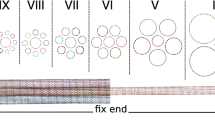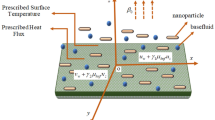Abstract
The enormous amount of basic research into carbon nanotubes has sparked interest in the potential applications of these novel materials. One promising use of carbon nanotubes is as fillers in a composite material to improve mechanical behaviour1,2, electrical transport3,4 and thermal transport5,6. For composite materials with high thermal conductivity, the thermal conductance across the nanotube–matrix interface is of particular interest. Here we use picosecond transient absorption to measure the interface thermal conductance (G) of carbon nanotubes suspended in surfactant micelles in water. Classical molecular dynamics simulations of heat transfer from a carbon nanotube to a model hydrocarbon liquid are in agreement with experiment. Our findings indicate that heat transport in a nanotube composite material will be limited by the exceptionally small interface thermal conductance (G ≈ 12 MW m−2 K−1) and that the thermal conductivity of the composite will be much lower than the value estimated from the intrinsic thermal conductivity of the nanotubes and their volume fraction.
This is a preview of subscription content, access via your institution
Access options
Subscribe to this journal
Receive 12 print issues and online access
$259.00 per year
only $21.58 per issue
Buy this article
- Purchase on Springer Link
- Instant access to full article PDF
Prices may be subject to local taxes which are calculated during checkout




Similar content being viewed by others
References
Ajayan, P.M., Schadler, L.S., Giannaris, C. & Rubio, A. Single-walled carbon nanotube-polymer composites: Strength and weakness. Adv. Mater. 12, 750–753 (2000).
Allaoui, A., Bai, S., Cheng, H.M. & Bai, J.B. Mechanical and electrical properties of a MWNT/epoxy composite. Composites Sci.Technol. 62, 1993–1998 (2002).
Kilbride, B.E. et al. Experimental observation of scaling laws for alternating current and direct current conductivity in polymer–carbon nanotube composite thin films. J. Appl. Phys. 92, 4024–4030 (2002).
Benoit, J.-M., Corraze, B., Lefrant, S., Bernier, P. & Chauvet, O. Electric transport properties and percolation in carbon nanotubes/PMMA composites. Mater. Res. Soc. Symp. Proc. 706, Z3.28.1–Z3.28.5 (2002).
Choi, S.U.S., Zhang, Z.G., Yu, W., Lockwood, F.E. & Grulke, E.A. Anomalous thermal conductivity enhancement in nanotube suspensions. Appl. Phys. Lett. 79, 2252–2254 (2001).
Biercuk, M.J. et al. Carbon nanotube composites for thermal management. Appl. Phys. Lett. 80, 2767–2769 (2002).
Kim, P., Shi, L., Majumdar, A. & McEuen, P.L. Thermal transport measurements of individual multiwalled nanotubes. Phys. Rev. Lett. 87, 215502-1–215502-4 (2001).
Berber, S., Kwon, Y.-K. & Tománek, D. Unusually high thermal conductivity of carbon nanotubes. Phys. Rev. Lett. 84, 4613–4616 (2000).
Nan, C.W., Birringer, R., Clarke, D.R. & Gleiter, H. Effective thermal conductivity of particulate composite with interfacial thermal resistance. J. Appl. Phys. 81, 6692–6699 (1997).
Swartz, E.T. & Pohl, R.O. Thermal boundary resistance. Rev. Mod. Phys. 61, 605–668 (1989).
Cahill, D.G., Goodson, K. & Majumdar, A. Thermometry and thermal transport in micro/nanoscale solid-state devices and structures. J. Heat Transfer 124, 223–241 (2002).
Costescu, R.M., Wall, M.A. & Cahill, D.G. Thermal conductance of epitaxial interfaces. Phys. Rev. B 67, 54302-1–54302-5 (2003).
O'Hara, K.E., Hu, X. & Cahill, D.G. Characterization of nanostructured metal films by picosecond acoustics and interferometry. J. Appl. Phys. 90, 4852–4858 (2001).
Wilson, O.M., Hu, X., Cahill, D.G. & Braun, P.V. Colloidal metal particles as probes of nanoscale thermal transport in fluids. Phys. Rev. B 66, 224301-1–224301-6 (2002).
Bachilo, S.M. et al. Structure-assigned optical spectra of single-walled carbon nanotubes. Science 298, 2361–2366 (2002).
Strano, M.S. Assignment of (n,m) Raman and optical features of metallic single walled carbon nanotubes. Nano Lett. (in the press).
Lauret, J.S. et al. Ultrafast carrier dynamics in single-wall carbon nanotubes. Phys. Rev. Lett. 90, 057404-1–05704-4 (2003).
O'Connell, M.J. et al. Band gap fluorescence from individual single-walled carbon nanotubes. Science 297, 593–596 (2002).
Touloukian, Y.S. Thermophysical Properties of Matter (IFI/Plenum, New York, 1979).
Strano, M.S. et al. The role of surfactant adsorption during ultrasonication in the dispersion of single-walled carbon nanotubes. J. Nanosci. Nanotech. 3, 81–86 (2003).
Strano, M.S. et al. Reversible, band-gap selective protonation of single walled carbon nanotubes in solution. J. Phys. Chem. (in the press).
Richard, C., Balavoine, F., Schultz, P., Ebbesen, T.W. & Mioskowski, C. Supramolecular self-assembly of lipid derivatives on carbon nanotubes. Science 300, 775–778 (2003).
Hone, J., Batlogg, B., Benes, Z., Johnson, A.T. & Fischer, J.E. Quantized phonon spectrum of single-wall carbon nanotubes. Science 289, 1730–1733 (2000).
Bronikowski, M.J., Willis, P.A., Colbert, D.T., Smith, K.A. & Smalley, R.E. Gas-phase production of carbon single-walled nanotubes from carbon monoxide via the HiPco process: A parametric study. J. Vacuum Sci. Technol. A 19, 1800–1805 (2001).
Discover®, Forcefield Simulation User Guide (Molecular Simulations Inc., San Diego, 1996).
Sun, H., Mumby, S.J., Maple, J.R. & Hagler, A.T. An ab initio CFF93 all-atom force field for polycarbonates. J. Am. Chem. Soc. 116, 2978–2987 (1994).
CRC Handbook of Chemistry and Physics (Chemical Rubber Publishing, Boca Raton, 1985–1986).
Acknowledgements
This work was supported by DOE Grant No. DEFG02-01ER45938 and NSF Grant No. CTS 99-78822. Sample characterization used the facilities of the Center for Microanalysis of Materials, which is partly supported by the US Dept of Energy under Grant No. DEFG02-91-ER45439. This work was also supported by the Petroleum Research Fund, Grant No. PRF36305-G9, NSF Grant No. DMR 134725, and a grant from Phillip Morris, USA.
Author information
Authors and Affiliations
Corresponding author
Ethics declarations
Competing interests
The authors declare no competing financial interests.
Rights and permissions
About this article
Cite this article
Huxtable, S., Cahill, D., Shenogin, S. et al. Interfacial heat flow in carbon nanotube suspensions. Nature Mater 2, 731–734 (2003). https://doi.org/10.1038/nmat996
Received:
Accepted:
Published:
Issue Date:
DOI: https://doi.org/10.1038/nmat996
This article is cited by
-
Atomically precise photothermal nanomachines
Nature Materials (2024)
-
Facile synthesis of cellulose and fly-ash based sustainable nanohybrids for thermal insulation applications
Cellulose (2023)
-
Superinsulating BNNS/PVA Composite Aerogels with High Solar Reflectance for Energy-Efficient Buildings
Nano-Micro Letters (2022)
-
Thermal Transport across Polyethylene Chains
Journal of Thermal Science (2022)
-
Effect of carbon nanotubes loading and pressure on the performance of a polyethersulfone (PES)/carbon nanotubes (CNT) membrane
Scientific Reports (2021)



